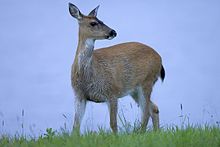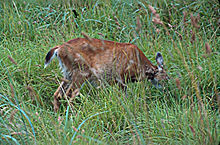zh-TW
在導航的名稱

The Sitka deer or Sitka black-tailed deer (Odocoileus hemionus sitkensis) is a subspecies of mule deer (Odocoileus hemionus), similar to the Columbian black-tailed subspecies (O. h. colombianus). Their name originates from Sitka, Alaska, and it is not to be confused with the similarly named sika deer. Weighing in on average between 48 and 90 kg (106 and 198 lb), Sitka deer are characteristically smaller than other subspecies of mule deer. Reddish-brown in the summer, their coats darken to a gray-brown in mid- to late August. They are also good swimmers, and can occasionally be seen crossing deep channels between islands. Their average lifespan is about 10 years, but a few are known to have attained an age of 15.[1]


Sitka deer inhabit the coastal rainforests of northern British Columbia and southeastern Alaska. Their natural distribution included the Alexander Archipelago in Alaska and the adjacent mainland coast north to Yakutat. They were also introduced to Haida Gwaii (Queen Charlotte Islands) in the 1890s, Prince William Sound during 1917–1923, the Kodiak Island Archipelago in 1924 and 1930, Yakutat in 1924, and the Skagway and Haines area during the 1950s.[2]
Sitka deer can be both migratory and residential depending on their habitat; but during winter, they primarily reside in old or mixed-age forest growth below 1,500 feet (460 m), except on the southern two-thirds of Kodiak Island, where forest cover is absent.[3] The rut peaks in mid-November and fawns are born in early June; they weigh 6–8 lb (2.7–3.6 kg). Bucks can weigh up to 120–200 lb (54–91 kg) and does can weigh 80–100 lb (36–45 kg).
Sitka deer primarily eat green vegetation. However, during the intense Alaskan winters, they also feed on woody vegetation and lichens. Sitka deer have no upper incisors, and digest vegetation through grinding plant material between their upper and lower molars. All Odocoileus species are ruminants, in that they have four-chambered stomachs which allow them to "ruminate" (rechew) their food, and contains bacteria specialized in breaking down cellulose. Since these bacteria are so specialized, they have tremendous difficulty digesting strange material and can die of starvation with their bellies full of food. Sitka deer feed on several plants, including Cornus, foam flower, trailing raspberry, fern leaf golden thread, Vaccinium, hemlock/cedar, and salmon berry bush.
Sitka deer population fluctuate considerably due to the harsh Alaskan winters and are typically estimated using pellet surveys, DNA, photo traps and other methods. However, they are an abundant species that rapidly recovers from low populations, especially on Admiralty, Baranof, Chichagof, Kodiak, and other islands where wolves are naturally absent. They are not designated at risk. Introduced in the 19th century, Sitka deer have become abundant on the islands of Haida Gwaii, overgrazing local flora, so the Haida Nation forest guardian program encourages meat hunting to reduce total numbers.[4]
Natural predators include wolves, mountain lions, grizzly bears, and American black bears; credible reports have reported killer whales taking them while swimming in deeper water. Human predation seems to have little to no effect on Sitka deer populations. However, habitat loss from clear-cutting old growth forests may contribute to population decline.[5] Normal adult antlers are often small in size; very few deer score above a 110 on the Boone and Crockett system.
Logging practices can affect the populations of the Sitka black-tailed deer. While clearcutting is thought to provide more and better habitat for the Sitka deer clear-cutting can also have a diverse effect on the deer. Hunters have always focused on these clearcut areas and for good reason. However, when the winter has deep snow these clearcut areas are covered leaving less food when the Sitka needs it most. A secondary problem is the energy that is needed for the deer to travel through these areas when the snow is so deep.
The Sitka deer or Sitka black-tailed deer (Odocoileus hemionus sitkensis) is a subspecies of mule deer (Odocoileus hemionus), similar to the Columbian black-tailed subspecies (O. h. colombianus). Their name originates from Sitka, Alaska, and it is not to be confused with the similarly named sika deer. Weighing in on average between 48 and 90 kg (106 and 198 lb), Sitka deer are characteristically smaller than other subspecies of mule deer. Reddish-brown in the summer, their coats darken to a gray-brown in mid- to late August. They are also good swimmers, and can occasionally be seen crossing deep channels between islands. Their average lifespan is about 10 years, but a few are known to have attained an age of 15.
Rusa sitka atau rusa rekor-hitam sitka (Odocoileus hemionus sitkensis) adalah subspesies rusa Odocoileus hemionus) yang mirip dengan subspesies rusa ekor-hitam Kolumbia O. h. colombianus). Rusa ini dinamai dari kota Sitka di Alaska dan tidak sama dengan rusa sika. Dengan rata-rata massa sekitar 36 hingga 54 kg, rusa sitka umumnya lebih kecil daripada subspesies rusa Odocoileus hemionus lainnya. Rusa ini berwarna coklat kemerahan pada musim panas, tetapi warna mereka berubah menjadi abu-abu-coklat pada musim dingin. Mereka juga adalah perenang yang handal, dan kadang-kadang terlihat sedang menyeberangi selat yang dalam. Rentang usia mereka dapat mencapai sepuluh tahun, tetapi ada beberapa yang hidup sampai berumur 15 tahun.[1]
Rusa sitka atau rusa rekor-hitam sitka (Odocoileus hemionus sitkensis) adalah subspesies rusa Odocoileus hemionus) yang mirip dengan subspesies rusa ekor-hitam Kolumbia O. h. colombianus). Rusa ini dinamai dari kota Sitka di Alaska dan tidak sama dengan rusa sika. Dengan rata-rata massa sekitar 36 hingga 54 kg, rusa sitka umumnya lebih kecil daripada subspesies rusa Odocoileus hemionus lainnya. Rusa ini berwarna coklat kemerahan pada musim panas, tetapi warna mereka berubah menjadi abu-abu-coklat pada musim dingin. Mereka juga adalah perenang yang handal, dan kadang-kadang terlihat sedang menyeberangi selat yang dalam. Rentang usia mereka dapat mencapai sepuluh tahun, tetapi ada beberapa yang hidup sampai berumur 15 tahun.
Het sitkahert (Odocoileus hemionus sitkensis) is een hertachtige en ondersoort van het muildierhert en lijkt op een andere ondersoort, het zwartstaarthert (O. h. colombianus). Het sitkahert moet niet verward worden met het sikahert, een andere hertensoort.
De soort is genoemd naar de plaats Sitka in Alaska. De meeste sitkaherten wegen tussen de 36 en 54 kg. Sitkaherten zijn kleiner dan andere ondersoorten en hebben een roodbruine vacht in de zomer, die in de winter grijsbruin wordt.
Sitkaherten kunnen goed zwemmen en zwemmen vaak over grote rivieren. De gemiddelde maximumleeftijd ligt rond 10 jaar, maar sommige individuen worden 15 jaar oud.
De dieren komen voor in Brits-Columbia, Canada en zuidoost Alaska. Verder komen ze ook voor op de eilanden van de Alexanderarchipel, Prince William Sound, Kodiak Archipel en de Koningin Charlotte-eilanden.
Het sitkahert (Odocoileus hemionus sitkensis) is een hertachtige en ondersoort van het muildierhert en lijkt op een andere ondersoort, het zwartstaarthert (O. h. colombianus). Het sitkahert moet niet verward worden met het sikahert, een andere hertensoort.
Hươu Sitka hoặc Hươu đuôi đen Sitka (tên khoa học: Odocoileus hemionus sitkensis) là một phân loài của hươu la (Odocoileus hemionus) và tương tự như phân loài hươu đuôi đen Columbia (Odocoileus hemionus colombianus). Tên của chúng bắt nguồn từ địa danh Sitka, Alaska.
Hươu Sitka sống trong rừng nhiệt đới ven biển phía bắc British Columbia, Canada và Đông Nam Alaska, Hoa Kỳ. Hươu cũng được tìm thấy trên các hòn đảo của Quần đảo Alexander, Prince William Sound, quần đảo Kodiak và Haida Gwaii (Queen Charlotte Islands), British Columbia. Hươu Sitka có thể di cư và dân số chúng phụ thuộc vào môi trường sống, trong những tháng mùa đông chúng chủ yếu cư trú tại rừng già hoặc rừng hỗn hợp dưới 1.500 feet (46,000 cm).
Số lượng Hươu Sitka luôn dao động đáng kể do mùa đông khắc nghiệt ở Alaska. Tuy nhiên, đây là một loài phong phú và nhanh chóng phục hồi. Chúng là con mồi ưa thích của nhiều loài động vật ăn thịt tự nhiên như chó sói, gấu nâu và gấu đen Mỹ. Con người săn hươu dường như không xảy ra nhiều, tuy nhiên việc khai thác gỗ đã được chứng minh là ảnh hưởng xấu đến quần thể của chúng.
Những con hươu tơ được sinh ra trong đầu tháng sáu và cân nặng 6-8 kg (2,7-3,6 kg). Hươu đực trưởng thành có thể nặng tới 120-200 pounds (54-91 kg) và hươu cái có thể nặng 80-100 pounds (36–45 kg). Với trọng lượng trung bình từ 80 đến 120 cân Anh (từ 36 đến 54 kg), hươu Sitka có đặc trưng nhỏ hơn so với các phân loài của hươu la. Chúng có màu nâu đỏ vào mùa hè, lông của chúng trở thành màu xám nâu vào mùa đông. Loại nay này cũng là những kẻ bơi lội tốt, và đôi khi có thể được nhìn thấy chúng bơi qua các kênh sâu giữa các đảo. Tuổi thọ trung bình của chúng là khoảng 10 năm nhưng một số ít được biết đến đã đạt được 15 tuổi.
Hươu Sitka chủ yếu ăn thực vật màu xanh lá cây. Tuy nhiên trong mùa đông Alaska chúng cũng sẽ ăn thực vật thân gỗ và địa y. Hươu Sitka không có răng cửa phía trên và tiêu hóa thực vật thông qua nghiền nguyên liệu thực vật giữa răng hàm trên và hàm dưới của chúng. Tất cả các loài Odocoileus là động vật nhai lại, trong đó họ có một dạ dày bốn ngăn bốn cho phép họ nghiền ngẫm thức ăn, và có chứa vi khuẩn chuyên phân hủy Cellulose. Tuy nhiên từ những vi khuẩn này gây khó khăn rất lớn tiêu hóa vật chất lạ và một con hươu có thể chết vì đói với bụng đầy thức ăn. Hươu Sitka cũng thích ăn quả mọng, mâm xôi, lá dương xỉ sợi vàng, cây độc cần/tuyết tùng và các loại quả mọng từ cây bụi.
Hươu Sitka hoặc Hươu đuôi đen Sitka (tên khoa học: Odocoileus hemionus sitkensis) là một phân loài của hươu la (Odocoileus hemionus) và tương tự như phân loài hươu đuôi đen Columbia (Odocoileus hemionus colombianus). Tên của chúng bắt nguồn từ địa danh Sitka, Alaska.